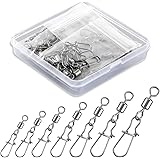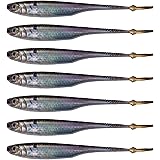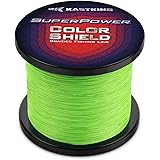Successfully targeting surf halibut requires an understanding of their behavior and a refined approach to lure presentation. As briefly highlighted in the accompanying video, several key techniques are considered crucial for enticing these elusive flatfish from their sandy ambush points. A systematic application of these methods greatly increases the potential for a productive fishing session along coastal waters. Specific adjustments to retrieve speed, rod action, and post-cast practices can make a significant difference in your overall success.
Mastering the Initial Cast and Slack Line Management for Surf Halibut
One of the most immediate actions after a cast is the efficient management of slack line, as correctly emphasized in the video. This step is critically important when targeting surf halibut with a lure such as the Lucky Craft. Following the lure’s splashdown, it is often noticed that excess line forms on the water’s surface, particularly in breezy conditions or when fishing in a strong current. This redundant line creates a significant barrier between the angler and the lure, thereby impeding direct control.
Imagine if a halibut were to strike your lure while a substantial amount of slack line was present; the subtle take might not be felt through the rod. Furthermore, the necessary power transfer for a solid hook set would be significantly diminished. Therefore, it is advised that the reel be engaged immediately after the lure hits the water, and any visible slack should be reeled in as quickly as practically possible without moving the lure prematurely. This action establishes a direct connection, ensuring that every twitch, bump, or strike from a surf halibut is effectively transmitted through the line to the angler’s hand. Maintaining this tight line is a foundational principle of effective surf fishing, allowing for superior feel and response.
Implementing the Rod Twitch Technique for Enticing Halibut
The strategic use of an upward or downward rod twitch is a subtle yet highly effective technique for stimulating strikes from surf halibut. A lure, even one as well-designed as a Lucky Craft, can appear somewhat lifeless if merely reeled in at a constant pace. The introduction of periodic twitches imparts an erratic, natural movement that mimics distressed baitfish or other prey items struggling in the current. Such movements are known to trigger the predatory instincts of halibut, which are opportunistic feeders.
When an upward twitch is applied, the lure is observed to dart upwards in the water column before settling back down. This motion can simulate a baitfish attempting to escape from a predator or reacting to current surges. Conversely, a downward twitch can cause the lure to dive or swim erratically towards the bottom, which is often where surf halibut position themselves. These actions create flashes, vibrations, and changes in direction that are highly visible and detectable to flatfish waiting in ambush. It is suggested that these twitches be varied in intensity and frequency; an unpredictable retrieve often proves more successful than a monotonous one. The occasional pause after a twitch can also allow the lure to suspend or flutter, presenting an easy target for a lurking halibut.
Understanding the Behavior of Surf Halibut
For these techniques to be most effective, a basic understanding of surf halibut behavior is beneficial. California halibut, for instance, are ambush predators that prefer sandy or muddy bottoms, often residing in areas where structure or subtle depth changes offer concealment. They are masters of camouflage, blending seamlessly with the seafloor. Their feeding strategy involves lying in wait, often partially buried, and lunging at unsuspecting prey that comes within striking distance. Therefore, a lure that closely simulates natural prey behavior and movement, particularly near the bottom, will naturally be more appealing. The twitches, along with a slow retrieve, are designed to keep the lure in the halibut’s strike zone for an extended period, increasing the chances of detection and a subsequent attack.
The Art of the Slow Retrieve for Persistent Halibut Angling
A slow retrieve is considered paramount when targeting surf halibut, constituting a critical element of successful angling. Many anglers, accustomed to faster retrieves for other species like striped bass or corbina, might inadvertently pull their Lucky Craft lures too quickly past the potential strike zone of a halibut. However, halibut are not typically fast-chasing predators over long distances. They prefer to conserve energy, waiting for prey to come within easy reach. Therefore, a very slow and deliberate retrieve speed is advised, ensuring the lure remains in the ‘strike window’ for as long as possible.
Imagine if your lure, representing a tasty meal, is zooming past a halibut at high speed; it might not have sufficient time to react, assess the target, or commit to a strike. Conversely, a lure that is retrieved slowly allows the halibut ample opportunity to observe the presentation, track its movement, and finally, make its move. This slow pace permits the lure to maintain contact with the bottom, occasionally kicking up puffs of sand or mud, which can further mimic a foraging baitfish and attract attention. It is also important to consider the lure’s design; the Lucky Craft, with its specific weighting and lip, is often designed to achieve a certain action at slower retrieve speeds. A retrieve that is just fast enough to impart the lure’s intended wobble or darting action, but no faster, is typically considered ideal for catching surf halibut.
The Crucial Step of Setting the Hook on a Surf Halibut
Finally, the moment of truth arrives: setting the hook. This seemingly simple action is often where many opportunities to land a surf halibut are lost. When a strike is felt, which can range from a subtle tap to a solid thud, a quick and firm hook set is absolutely necessary. Halibut possess a relatively bony mouth structure, requiring adequate force to properly embed the hook. It is often recommended that a sweeping motion of the rod upwards or to the side be employed, pulling the line taut and driving the hook point into the fish’s jaw.
Imagine if a light, hesitant hook set is attempted after feeling a bite; the hook might only graze the halibut’s mouth, resulting in a lost fish during the fight. A forceful, yet controlled, snap of the wrist and forearm, combined with a quick reel turn to take up any new slack created, typically ensures a solid connection. It is important not to confuse a snag on the bottom with a bite; however, if any unusual resistance or “weight” is felt, it is generally prudent to set the hook. This proactive approach often leads to successful landings, ensuring that the preceding efforts in casting, slack line management, rod twitching, and slow retrieves are duly rewarded with a prized surf halibut.








